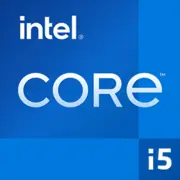Intel Core i5-12400

Intel Core i5-12400: A Comprehensive Review of the 2025 Processor
March 2025
Key Features: Alder Lake in Action
The Intel Core i5-12400 processor, released in late 2021, remains relevant in 2025 due to its successful combination of price and performance.
Architecture and Process Technology
- Alder Lake — a hybrid architecture divided into Performance-cores (P-cores) and Efficient-cores (E-cores). However, the i5-12400 utilizes only 6 P-cores (12 threads), simplifying the structure and reducing costs.
- Intel 7 (10 nm Enhanced SuperFin) — a process technology that ensures high energy efficiency.
- Frequencies: Base — 2.5 GHz, maximum in turbo mode — 4.4 GHz.
Performance
- Geekbench 6: 2170 (Single-Core), 8817 (Multi-Core). In comparison, this is 15% higher than the Ryzen 5 5600X in single-threaded tasks.
- Cache: 18 MB L3 — sufficient for caching data in games and work applications.
Key Features
- Support for PCIe 5.0 (up to 16 lanes) — relevant for next-gen SSDs and graphics cards.
- Intel UHD Graphics 730 — integrated graphics for office tasks and emergency situations (e.g., in case of discrete graphics card failure).
Compatible Motherboards: Sockets and Chipsets
LGA 1700 Socket — a universal platform for 12th and 13th generation Intel processors.
Recommended Chipsets
1. H610 (from $70): Budget option without overclocking and PCIe 5.0. Suitable for office PCs.
2. B660 (from $110): Optimal choice for i5-12400. Includes PCIe 5.0 for graphics cards, supporting both DDR4/DDR5.
3. H670 (from $140): More PCIe lanes and USB ports. For upgrade-oriented builds.
4. Z690 (from $180): Excessive for i5-12400, but relevant if planning to upgrade to Core i7/i9.
Examples of Motherboards
- MSI Pro B660M-A ($120): Best price/performance ratio, stable operation with DDR4.
- ASUS TUF Gaming H670-Pro ($160): Enhanced power and cooling system.
Memory: DDR4 vs DDR5
The processor supports both types of memory, but the choice depends on the motherboard:
- DDR4-3200: Budget option. 32 GB (2x16 GB) will cost $80–100. Suitable for gaming and most tasks.
- DDR5-4800: More expensive (32 GB — $120–150), but provides a 5-10% increase in bandwidth-sensitive applications (e.g., rendering in Blender).
Tip: For gaming with a graphics card like the NVIDIA RTX 4060, the difference between DDR4 and DDR5 is nearly negligible. DDR5 makes sense in workstations.
Power Supply: Power Calculation
With a TDP of 65 watts, the processor has a modest impact on power consumption. Recommendations:
- Without a discrete graphics card: A PSU of 300–400 watts (e.g., be quiet! Pure Power 11 400W, $55).
- With a graphics card (NVIDIA RTX 4070 or AMD RX 7700 XT): A PSU of 600–650 watts (Corsair RM650x, $100).
- 80 Plus Bronze/Gold certification is essential for stability.
Pros and Cons
Pros:
- Price: $160–180 (new) vs. $220–250 for Ryzen 5 7600X.
- Energy efficiency: Consumes up to 40% less power than the i5-12600K.
- PCIe 5.0: Support for future SSDs and graphics cards.
Cons:
- No overclocking — the multiplier is locked.
- UHD 730 is weaker than AMD Vega 7 in Ryzen 5 5600G.
Use Cases
1. Gaming: In conjunction with RTX 4060 Ti, it provides 60+ FPS in Cyberpunk 2077 (1080p, Ultra).
2. Work Tasks: Quick rendering in Premiere Pro (4K projects), code compilation.
3. Multimedia: Streaming in OBS without lag thanks to 12 threads.
Real User Experience: Users note that the processor efficiently handles 10+ Chrome tabs, Discord, and gaming simultaneously.
Comparison with Competitors
1. AMD Ryzen 5 5600X ($150): Lacks in single-threaded performance (Geekbench 6 SC: 1980) but is cheaper.
2. AMD Ryzen 5 7600X ($220): Stronger in multi-threaded tasks (Geekbench 6 MC: 10500) but requires expensive AM5 motherboards and DDR5.
Conclusion: The i5-12400 surpasses the Ryzen 5 5600X in 2025 but falls short against the Ryzen 5 7600X in heavy work tasks.
Practical Assembly Tips
1. Cooling: The stock cooler is sufficient, but for quieter operation, consider the DeepCool AK400 ($35).
2. Case: Choose models with ventilation (NZXT H510 Flow, $80).
3. Example Build:
- Motherboard: Gigabyte B660 DS3H ($110).
- Memory: Kingston Fury DDR4-3200 32 GB ($90).
- Graphics Card: NVIDIA RTX 4060 ($300).
- Total Price: ~$800 excluding SSD and PSU.
Final Conclusion: Who Should Consider the i5-12400?
This processor is an ideal choice for:
- Gamers looking to save on the CPU to invest more in the graphics card.
- Office users — operates quietly and coolly even under load.
- Upgrade enthusiasts: The LGA 1700 platform allows for an upgrade to i7-13700K without replacing the motherboard.
Why in 2025? The price has dropped to $160–180, and its performance is sufficient for all current tasks. If maximum FPS in 4K or 8K video rendering is not required, it's the optimal choice.
Basic
CPU Specifications
Memory Specifications
GPU Specifications
Miscellaneous
Benchmarks
Compared to Other CPU
Related CPU Comparisons
Share in social media
Or Link To Us
<a href="https://cputronic.com/en/cpu/intel-core-i5-12400" target="_blank">Intel Core i5-12400</a>

